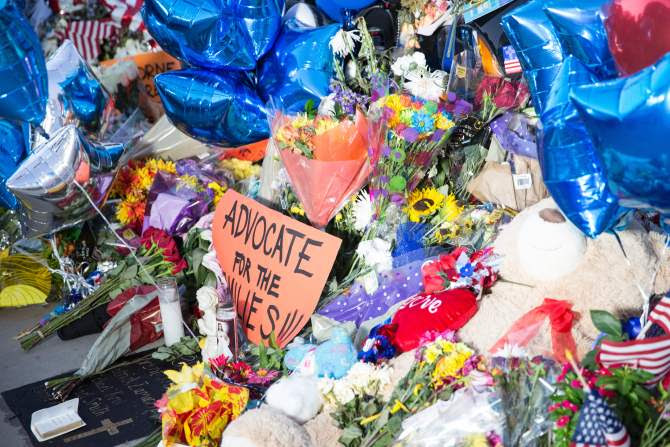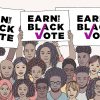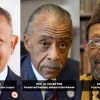By: Charles D. Ellison
 Mourners sing and clap their hands at the Police Headquarters memorial for officers killed in the recent sniper attack in Dallas, Texas on July 10, 2016. The gunman who opened fire on Dallas officers during a protest against US police brutality, leaving five dead and seven others wounded, told negotiators he wanted to kill white cops, the city’s police chief said July 8. LAURA BUCKMAN/AFP/Getty Images
Mourners sing and clap their hands at the Police Headquarters memorial for officers killed in the recent sniper attack in Dallas, Texas on July 10, 2016. The gunman who opened fire on Dallas officers during a protest against US police brutality, leaving five dead and seven others wounded, told negotiators he wanted to kill white cops, the city’s police chief said July 8. LAURA BUCKMAN/AFP/Getty ImagesThe political climate had already incubated into the most racially flammable presidential election cycle in recent memory (perhaps more so than when the first black president ran). Throw a lit match of tragic police assassinations by heavily-armed vengeful black man on it, and it may have just exploded into a summer surprise inflection point that determines who goes to the White House.
It all depends on white voters.
Dallas is where that tense, volatile intersection of race and politics might reach a nightmarish electoral critical mass. Generally speaking, many white voters were already increasingly frantic over the fast-action demographic changes before them as their share of the population declined two full percentage points down to 64.6 percent since 2012. Look no further than this past Republican presidential primary for proof. Witness the ease with which white Republicans and independents embrace the colorful racist demagoguery of one orange-haired lunatic.
What’s worrisome is how that translates electorally post-Dallas. What will a white voter do?
That’s a mystery at the moment until we see new data in the coming weeks. Up till last week, election watchers placed enormous chunks of faith in a general election white electorate restrained enough not to pull the same visceral populist stunt in full view during the GOP primary. “If Donald Trump reaches 63 or 64 percent white voter support then, yeah, it’s time for Democrats to worry,” Lincoln Park Strategies Stefan Hankin told The Root during a conversation back in June. Hankin was pretty confident it wouldn’t get to that. As he pointed out, the sheer force of so many anticipated black and brown voters vastly dilutes white voter impact – Mitt Romney in 2012 obviously couldn’t pull it off with 59 percent white voter share.
But with 25-year old Micah Xavier Johnson arming up for a Nat Turner resurrection, there’s bits of data to suggest a tectonic political plate crack in the offing. Could some white voters, essentially, over-react? Baseless finger pointing, told-you-so blame gaming are already jumping from a number of white conservatives and influential Tea Party mouthpieces eager to blast Black Lives Matter as the mastermind. It’s not just deleted Twitter threats either; it’s coming from a growing chorus of conservative thought leaders scapegoating every-black-body from President Obama to BLM.
While some might dismiss that as simply fringe viewpoint, that could actually metastasize into just the right amount of constant rhetorical exploitation and fear-mongering to increase white voter support for Trump. As FiveThirtyEight’s David Wasserman suggests, Trump can “offset” non-white voter gains with just “a 1 percentage point increase in the GOP share of the vote among non-Hispanic whites versus 2012 [and] a 3-point increase of non-Hispanic white turnout, from 64 percent in 2012 to 67 percent in 2016.”
If that’s the case, there’s not a lot of work for Trump to do. And it gets easier for him should white voter insecurity in the wake of Dallas trigger a fragile grab for what they believe makes them safe. Northwestern University researchers Maureen Craig and Jennifer Richeson call that a “perceived status threat” in which “exposure to the majority-minority [demographic] shift increases whites’ endorsement of conservative political ideology and policy positions.”
If that’s typically occurring just off “perceived” threat to political status, then what’s the reaction when there’s an armed threat against their first line of defense: law enforcement?
We’ll see the answer to that question soon. What we do know is that white voters clearly never liked Black Lives Matter or what it stood for in the first place. Dallas just threw up an excuse for white folks to hate it even more.
The Pew Research poll on race relations (released weeks before Dallas) already showed white voters foul on Black Lives Matter. Only 12 percent of whites claimed to understand its goals, and just 14 percent strongly supported it.
Those findings matched the results in an earlier April YouGov poll showing a solid 61 percent of white voters asked disliking BLM – compared to the 68 percent of black voters who viewed it favorably.
And in a revealing September 2015 PBS NewsHour and Marist College Institute for Public Opinion poll, 41 percent of whites were convinced BLM “advocated violence” – when clearly it hadn’t.
Going back to Trump: he’s still formidable. Despite the casual arrogance of mainstream pundits who assume “nah, Americans won’t go that far,” this race is still too close for anyone to call early. For someone who’s not spending money on ads, is constantly clowned by media and who can’t articulate a policy position, Trump is still putting numbers on the board five months out. He didn’t ask for money in June, and yet he managed to raise $52 million of mostly small under-$200 contributions, shutting up critics who lampooned him for the $1.3 million cash-on-hand the month before. Hillary Clinton holds a lead, but she can’t slip: The RealClearPolitics polling average places Trump just less than 5 percentage points behind Clinton. And even with a Reuters/Ipsos poll here which put her ahead by 11 and a Pew Research poll there which gave her a 9-point spread, the number of surveys suggesting a tight race in November far outnumber the ones that don’t.
Continued Trump political appeal among a disturbingly high number of white voters polled is one big reason.
If the election were held today, 50 percent of white respondents surveyed in a recent YouGov/Economist poll suggested they would vote for Trump in a two-way race, nowhere close to the performance he’d need in November (but still high). Yet, it also shows a narrow majority of white voters, at 58 percent, who say they’re voting mostly for Trump over the 57 percent who say they’re voting mostly for Hillary Clinton.
Post-Dallas could see an inflammation of that. The country was already in a foul mood over its direction, with an average 66.5 percent of Americans believing it’s on the wrong track, a number that scarily matches our national demographic make-up of whites. And the YouGov poll which shows a staggering 71 percent of whites feeling downright miserable about where the nation’s headed just made it worse. As the nation gets black and browner, white nervousness rises.
Could Dallas morph into a Brexit-like scenario in which a rising wave of irrational white voters act out and elect Trump on November 8th? It’s possible: a sudden, unanticipated spike in white voter turnout mixed with much lower and uninspired black and Latino voter turnout could swing it. The next five months can only tell: But, on a political scale, what happened in Dallas certainly didn’t stay there. Micah Johnson’s rifle shots heard around the world made sure of that.
Charles D. Ellison is a veteran political strategist and a contributing editor at The Root. He is also Washington correspondent for the Philadelphia Tribune, a frequent contributor to The Hill, the weekly Washington insider for WDAS-FM in Philadelphia and host of The Ellison Report, a weekly public-affairs magazine broadcast and podcast on WEAA 88.9 FM Baltimore. Follow him on Twitter.














